ICU Nursing: Silicone Mattress vs. Traditional Foam Mattresses – A Clinical Perspective
The choice of an ICU bed mattress plays a critical role in patient outcomes, particularly for long-term bedridden individuals in intensive care units. Hospitals traditionally relied on foam medical mattresses for their cost-effectiveness and basic pressure redistribution properties. However, recent advancements have introduced silicone-based ICU mattresses as a superior alternative, offering enhanced pressure relief, infection control, and durability.

Pressure Redistribution: Silicone vs. Foam Medical Mattresses
One of the primary functions of an ICU mattress is to minimize pressure ulcers (bedsores), a common complication in critically ill patients. Traditional hospital bed foam mattresses use viscoelastic or high-resilience foam to distribute weight, but they often lose effectiveness over time due to material breakdown. In contrast, silicone ICU mattresses maintain consistent support due to their viscoelastic yet durable structure.
Clinical studies indicate that silicone’s adaptive properties allow for dynamic pressure redistribution, adjusting in real-time to patient movements. Unlike firm hospital bed mattresses, which may create excessive pressure points in immobile patients, silicone variants conform precisely to body contours, reducing peak interface pressures by up to 30%. This makes them particularly beneficial for high-risk patients, such as those with limited mobility or post-surgical cases requiring extended bed rest.
Infection Control: The Hygiene Advantage of Silicone ICU Mattresses
Hospital-acquired infections (HAIs) are a major concern in ICUs, and hospital mattresses can harbor bacteria, fungi, and viruses if not properly sanitized. Traditional foam medical mattresses are porous, making them difficult to disinfect thoroughly. Fluid spills and bodily secretions can penetrate deep into foam layers, creating a breeding ground for pathogens.
Silicone ICU bed mattresses, however, feature non-porous surfaces that resist microbial penetration. Many models are also treated with antimicrobial coatings, further reducing infection risks. Unlike hospital bed pads that require frequent changing, silicone mattresses can be wiped down with disinfectants without degrading, ensuring a sterile environment for immunocompromised patients. Hospitals adopting silicone mattresses report lower HAI rates, particularly for resistant strains like MRSA and C. difficile.
ICU Mattresses: Durability and Long-Term Cost Efficiency
While foam hospital mattresses are initially cheaper, their lifespan is significantly shorter due to material fatigue and frequent replacement needs. ICU mattresses endure constant use, and foam variants typically compress unevenly within months, leading to discomfort and increased pressure sore risks.
Silicone ICU mattresses, on the other hand, retain their structural integrity for years, even under continuous use. Their resistance to wear and tear reduces replacement costs, making them a cost-effective long-term investment. Additionally, unlike firm hospital bed mattresses, which may require additional hospital bed pads for pressure relief, silicone mattresses provide built-in support, eliminating the need for supplementary accessories.
Patient Comfort and Mobility Support of Foam Medical Mattresses
Comfort is crucial for ICU patients, many of whom experience pain, muscle atrophy, or restricted movement. Traditional foam medical mattresses often become too firm or too soft over time, failing to provide consistent support. Some patients may develop discomfort due to uneven sinking or excessive firmness in firm hospital bed mattresses.
Silicone mattresses offer a balanced solution—soft enough to prevent pressure sores yet supportive enough to aid in patient repositioning. Their responsive surface helps nurses turn patients more easily, reducing caregiver strain. Furthermore, silicone’s temperature-regulating properties prevent overheating, a common issue with foam-based alternatives.
Ease of Maintenance and Cleaning Protocols of Hospital Bed Pads
ICU mattresses require rigorous cleaning to meet hospital hygiene standards. Foam medical mattresses often need removable hospital bed pads and waterproof covers, adding layers that can trap moisture and bacteria. Deep cleaning foam is challenging, and frequent laundering of pads increases operational costs.
Silicone ICU bed mattresses simplify maintenance with seamless, waterproof surfaces that can be disinfected quickly. Unlike foam, they do not absorb liquids, preventing odor retention and bacterial growth. Hospitals using silicone mattresses report faster turnover times between patients, improving bed availability in high-demand ICU settings.
Clinical Recommendations: Which Mattress is Best for ICU Use?
From a clinical standpoint, silicone ICU mattresses outperform traditional foam hospital mattresses in nearly every critical aspect:
Pressure ulcer prevention – Superior weight distribution reduces bedsore incidence.
Infection control – Non-porous, antimicrobial surfaces lower HAI risks.
Durability – Longer lifespan reduces replacement frequency.
Caregiver efficiency – Easier patient repositioning and faster cleaning.
While foam medical mattresses remain a budget-friendly option for general wards, ICUs benefit significantly from upgrading to silicone-based solutions. Hospitals aiming to improve patient outcomes and operational efficiency should consider transitioning to advanced ICU bed mattresses with silicone technology.
The Future of ICU Mattress Design
The shift from traditional foam hospital mattresses to silicone-based ICU mattresses reflects broader trends in medical technology—prioritizing patient safety, caregiver efficiency, and long-term cost savings. As research continues to highlight the benefits of silicone in pressure relief and infection control, more healthcare facilities are expected to adopt these advanced solutions.
For ICUs striving to enhance patient care, investing in high-performance silicone ICU mattresses is not just an upgrade—it’s a necessity. By reducing complications like pressure ulcers and HAIs, these mattresses contribute to better recovery rates and lower hospital costs, making them the gold standard for critical care environments.
-
Multi-Layer Construction for Enhanced Performance in Gel Mattress PadЯңалыкларJun.24,2025
-
Innovative Features of the Latest Wave Mattress Designs in ICU SettingsЯңалыкларJun.24,2025
-
Innovations in Gel Memory Foam Layering and Zoned Support DesignЯңалыкларJun.24,2025
-
Hypoallergenic and Antibacterial Properties of Gel Memory Foam MattressesЯңалыкларJun.24,2025
-
Comparing Gel Memory Foam to Traditional Memory Foam: Comfort and DurabilityЯңалыкларJun.24,2025
-
Wave Mattress: An Innovative Care Solution for the Elderly and Bedridden PatientsЯңалыкларJun.11,2025
-
Wave Hybrid Mattress Circulation Improvement and Medical ConvenienceЯңалыкларJun.11,2025

